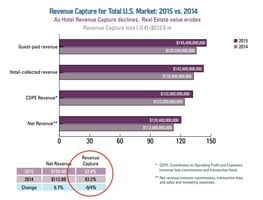By: Ryan Moran - Director, Product
Blog
New Techniques, Legacy Models and New Entrants Spell Disruption for Distribution
By: Cindy Estis Green, CEO & Co-Founder
As featured in the Fall 2016 issue of Hospitality Upgrade.

Excerpt from the new special report by Kalibri Labs, Demystifying the Digital Marketplace: Spotlight on the Hospitality Industry, and a Q&A with SVP/Managing Editor Geneva Rinehart.
The digital marketplace has undergone significant change since Distribution Channel Analysis: A Guide for Hotels was published in 2012.
Following a deep dive into the travel distribution landscape, three primary themes have emerged:
1. HOTELS ARE EXPLORING NEW TECHNIQUES FOR IMPLEMENTING REVENUE STRATEGY. An abundance of new online models has driven an imperative for hotels to shift from traditional, analog operating methods to a focus on digital. Current operating methods are costly and deployment is inefficient. This fact is evidenced by third-party commissions rising at twice the rate of revenue growth. Hotels previously tried to be available on every “shelf” but most have realized at this point that (1) it costs too much to be prominent in every distribution channel, and (2) the dominance of third-party intermediaries in the consumer path can undermine the relationship between hotel and consumer. Hotels will always have the opportunity to build a relationship during the actual stay experience but risk losing out on the connection made through inspiration, information gathering and booking phases of the travel journey. Third-party intermediaries are focused on developing their own customer bonds and have little incentive to facilitate the relationship between a hotel and its shared customer. Therefore, despite the mutual dependence between hotels and third parties, a sense of competition arises for owning the customer relationship. Two critical components of revenue strategy involve managing to a hotel’s optimal channel mix, including close tracking of acquisition costs, and differentiating the guest experience during the stay as well as in pre-stay and post-stay contact.
2. THE LEGACY OTA MODEL IS DECLINING. Apps and metasearch are gaining traction by providing consumers a more convenient and seamless experience across air, car, hotel and other components of travel. The legacy OTA model once assisted consumers by narrowing down lists of hundreds of hotels while still offering a wide range of options. A number of new models point to a next-generation consumer interface. With metasearch and social sites (like TripAdvisor and Facebook), along with some new apps (like Google Trips) now seamlessly integrating many elements of travel, the evolution toward a curated consumer experience is underway. In the meantime, some foundations of the traditional OTA model have been challenged. Through rigorous research on consumer clickstream data, the billboard effect was dismissed as a dead concept. The claim had been that OTAs drove multiple brand.com bookings for each one booked directly on the OTA site, but the research study, sponsored by the Consumer Innovation Forum and released in 2015, proved there is barely any lift in brand.com bookings as a result of visits to traditional OTAs. Further, some conditions that locked up hotel inventory and rates for third parties such as rate parity and last room availability are dissolving, whether from European regulators in multiple countries or changes in large chain agreements. This change is paving the way for greater autonomy by hotels and smaller third-party distributors. These changes will ultimately result in a more open and competitive marketplace.
3. NEW ENTRANTS SPELL DISRUPTION FOR SELECT CUSTOMER SEGMENTS. There are a few key segments in which disruption is imminent. Corporate travel has long relied upon legacy travel management companies handling the larger managed travel accounts. This is in contrast to a high degree of fragmentation on lightly managed and unmanaged business travel. New developments are likely to force change in the traditional RFP process for corporate accounts. These include: rate scanning with auto-cancel and rebook capability up until day of arrival, reward and incentive programs for travelers to self-police their own spending, aggressive moves by third parties to aggregate the lightly managed accounts, along with consolidation by hotel chains who don’t participate in annual rate bids. Corporate account activity will further be diverted by the aggregation of home and vacation rental markets, which will also create supply spikes during leisure high-demand periods. The groups and meetings market is ripe for disruption as well. The last five years have seen extensive offline third-party intermediation but no one has yet managed to aggregate this demand by offering a compelling online venue for casual or professional meeting planners to shop and book. Historically, the booking of groups and meetings has been inefficient and costly but indications are that the next 3 to 5 years will bring new options for this segment. This highly inefficient process may finally be streamlined with reduced costs and an improved experience for the consumer.
These three themes, along with many more, will be explored throughout Part 1 of Demystifying the Digital Marketplace: Spotlight on the Hospitality Industry.

Geneva Rinehart: If the cost of acquisition is rising out of control, is there any way for hotels to reverse that trend?
Cindy Estis Green: The costs have reached 15-25 percent of guest paid revenue. That is only second to labor costs an it has to be contained. I am not suggesting that it can be reduced by a huge margin just by paying attention to it, but you can't manage without measuring it. When airlines and car rental companies are low single-digit cost of sales, we know we can do better. Bringing the range down to 10-15 percent is a good target. Some hoteliers throw their hands up, saying they can't negotiate lower OTA commissions. Much of the net revenue improvements will not come from changes in the basic commission rates but rather through (1) better channel mix, (2) diversifying the sources of business, and (3) learning how to generate ancillary revenue.
Geneva Rinehart: What do you mean by an optimal channel mix for a hotel?How does a hotel go about finding it?
Cindy Estis Green: Every hotel has its own unique optimal channel mix. We have to start benchmarking against that optimal mix and not against average top-line revenue of a disparate group of hotels within a three-block radius that are not really comparable. A hotel has to learn all of its demand drivers and the cost of each and then test different scenarios to find the channel and segment mix that delivers the highest profit contribution. A hotel has to consider its physical condition, location, how it compares to competitors and its room/meeting space configuration. It has to be realistic about the limitations on sources of business, what it is capable of attracting and how much it costs to get that business. Then it has to tightly manage with maniacal focus to achieve its optimal mix targets.
Geneva Rinehart: You mentioned that hotels need to differentiate the guest experience. Are some companies better at this than others? Do you have any examples when it's done well?
Cindy Estis Green: Everyone thinks about how hard it is to acquire customers. Many of the brands are onto something now with a focus on growing their loyalty base. But they won’t make much progress without also putting some attention on the guest experience. If the booking and stay experience is different and unique, then guests will return. Good consumer product examples are Apple® and Amazon. CitizenM is a great example in hospitality. It generates 50 percent through brand.com and when it opens a new hotel, initially the majority comes through the OTA channels. It has no loyalty program but yet the experience has created a very strong, loyal base.
Geneva Rinehart: You suggest that OTAs will be overtaken by metasearch and apps, and yet Priceline has a larger market cap than all the hotel companies combined. Do you really see them in decline? What evidence are you seeing that tells you this is happening?
Cindy Estis Green: The OTAs are evolving and will continue to evolve. They aren’t going away. What we see is the consumer demand is evolving and providers are working toward that. For example, notice the money Expedia is putting into trivago advertising and Priceline is building KAYAK. They are both working on apps to include booking as well as guest service. And Google is launching Trips and Destinations – both apps that are likely to become competitive to the OTAs and the brand.com sites. Consumers want apps and other device-based access to information and booking. It’s consumer driven and those that provide the most compelling and convenient services to travel shoppers will win over the legacy booking options.
Geneva Rinehart: You noted some pretty big changes in the business travel segment. How do you think the corporate travel market will evolve?
Cindy Estis Green: The business travel market is ripe for disruption. It’s a lucrative base for hotels, and consumers are pretty savvy now with online shopping and buying. Some convention and routine business travel has already started to move to OTAs and metasearch. Travel management companies (TMCs) using the global distribution systems will still check other online sites before booking. If some new entrants make it easy for companies to save money and for travelers to quickly find affordable options, this market is bound to shift from the old traditional model with locked-in annual pricing through RFPs to a more dynamic model.
Geneva Rinehart: Airbnb is obviously a hot topic in the industry. Where and when do you see it affecting hotels?
Cindy Estis Green: Hotels are not uniformly affected by Airbnb. Our analysis so far shows that the primary period where Airbnb is potentially cutting into demand is due to lower compression during peak leisure periods like weekends and special events. During routine heavy compression periods in major cities, there is less overall impact – but at the segment level, there are distinct segments and rate categories where there is evidence of softening of peak rates. This will continue to evolve and change as more units are made available at the higher end of the market and as Airbnb gets more aggressive about the corporate market.
Geneva Rinehart: Ok, everyone wants to know if the book direct campaigns are really shifting more business to brand.com. Are the hotels getting higher profit margins?
Cindy Estis Green: Without getting into specifics, it is clear that the campaigns are shifting business. We see a lot of variation by market and by hotel segment. We will have more detailed recaps of the results in the U.S. market in Q4 when there is more data and time. I anticipate that with so many brands actively promoting book direct that the message to consumers will resonate. There may be some meaningful shift where consumers start to believe that booking on the direct channels has better benefits for them than third-party channels.



